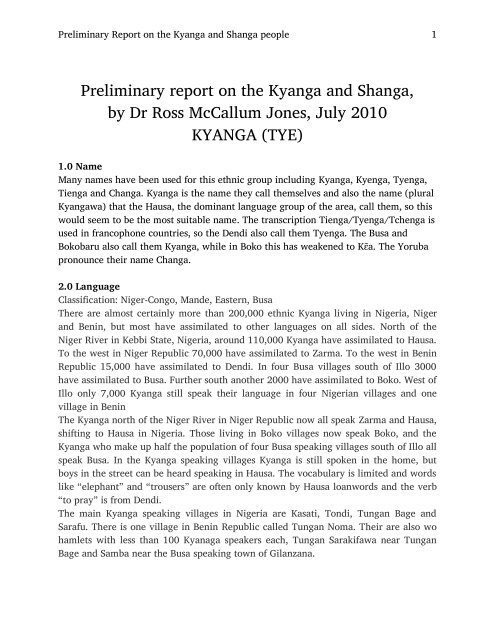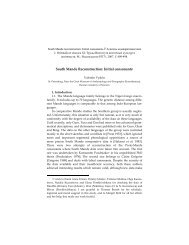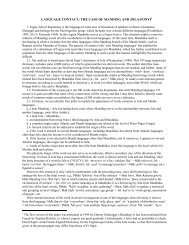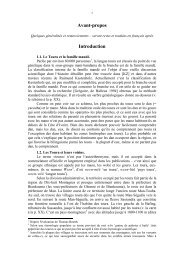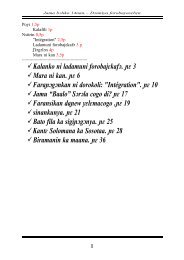by Dr Ross McCallum Jones July 2010 KYANGA (TYE)
Preliminary report on the Kyanga and Shanga, by Dr Ross ...
Preliminary report on the Kyanga and Shanga, by Dr Ross ...
You also want an ePaper? Increase the reach of your titles
YUMPU automatically turns print PDFs into web optimized ePapers that Google loves.
Preliminary Report on the Kyanga and Shanga people 4Kamba 60% Kyangakwai 99% Kwakkwaba 99%Fana 87% Buma 80% Fingila 98%Geza 60% Tungan Bana 98% Maidaji 95%Nibo 70% Tungan Je Tungan Muza 70%Tungan Rafi 78% Tungan Innami 98% Tungan Kokoni 90%Tungan Sule 98% Tungan Noma 98% Tungun Robo 80%Tungan Noma Mado 98% Tungan Zagi 70% Fagen Mata 98%Gamana 80% Shiko 70% Onah 80%Cidakai 80% Gorun Barmu 89% Gorun Yamma 80%Dorun Mallam 70% Sabon Gari 70% Wayekai 98%Dore Kaina 50% Tsika 50% Danbauri 50%Dogongaji 50% Godabe 80% Diggi 85%Hausa speaking Kaba people migrated to Dandi LGA and compete for leadership. Somevillages have Kaba chiefs because they cooperated with the colonialists when the thenpagan Kyanga resisted them.Benin Republic Estimated Kyanga population: Kyanga 15,000There are at least 19 villages with a majority Kyanga population and a combinedpopulation of about 15,000. Dendi, which is closely related to Zarma is their firstlanguage, followed <strong>by</strong> Hausa.Tungun Noma Kassa Galu Galu TeegiMↄↄkasa Kub ri (Banit ) Kwara Teegi Sↄmba KwaraKantoro Tolozugu Boifo KokiG n gaabi Karimama (Sarfu Sarakifawa)The last two villages may be in Nigeria, but according to my positioning in Google maps,they are in Benin. The following three small Kyanga villages (no Kyanga speakers) arefurther south towards the the Boko town of LougouTungan Goge Balalanga Tungan KarnaiMany Dendi in the Karimama/Malanville/Guéné area may have been originally Kyanga.Niger Republic (13) Mallam Idrissa estimates Kyanga population as 70,000.Garçon Loïc (1998 pp. 143-5) claims that 1% Niger‟s 9 million population in 1998 wasTienga, that is 90,000 people. They speak Dendi and live in the Gaya region. Furtherresearch is needed to clarify this number.There are at least 13 villages with significant Kyanga populations. Their first language isHausa and their second language is Zarma.
Preliminary Report on the Kyanga and Shanga people 6KOSOROMISHIRAWAKOSOROMISIRAThey have seven parallel scars on the right of the face and six on the left, beginningdiagonally from the crown of the head to the top of the ears, then vertically down to thebottom of the ears, and then diagonally forward, converging towards the mouth. TheMishira may have chicken foot markings on the body and are also called Baragu Kyanga(Borgu Kyanga). Kosoro Kↄsↄrↄ) have a V scar between the eyebrows and on the outsideof the eyes. Saaki have 3 vertical lines /// anywhere on the body in addition to normalmarkings.4.0 HistoryThe Shiba are reported to have come from Badr in Saudi Arabia and call their chief Bede.The other 3 groups are said to come from Misira (Egypt). Thus they share in the Kisiralegend that is so strong among the Boko/Busa people of Borgu and other groups inNigeria. According to this legend some ancestors fled from Mohammed and Islam in theMiddle East and eventually settled in Borgu, intermarrying with the local inhabitants(Boko). It may be true that some people came from the Middle East and intermarried withMande people, but it is not feasible to think of a West African Mande tribe like theKyanga as having originated from there. Linguistically all languages related to Kyengaand the Boko/Busa group are to the West of themThe Kyanga regard Mali Beri, a Zarma, as an ancestor.According to Olivier Walther in “Affaires de patrond, villes et commerce transfrontalienau Sahel” New ork 2008, the genealogy of the Kyanga chiefs of Kyangakwai is well
Preliminary Report on the Kyanga and Shanga people 8southern Dallol Fogha took a third.” Page 217-8: “As for the western trade, Baikie learnedin 1862 that Dallol Fogha salt „supplies the whole caravan road to Gonja.‟ Kebbimerchants, among others, took salt to Nupe, Ilorin and the middle Volta basin inexchange for kola. ... In the nineteenth century, however, the kola traders from Kano,Katsina and elsewhere were the main exporters of Dallol Fogha salt. In 1905 Loffler foundthat Tounouga and Gaya were major markets in this exchange; caravans brought textilesand leather goods from the east to exchange for salt. ... Other traders from the west andsouth also came to the Dallols, particularly the Wangara merchants of the various Baribatowns (Nikki, Bussa, Kiama). ... People came as far away as Yoruba country and Nupe, aswell as Borgu.” Page 221: “The only other saline for which there is early information isDallol Fogha, where radio-carbon dates indicate the presence of a salt industry in c. 1600.The close association between Dallol Fogha and Kebbi confirms this dating, and thetradition that salt production was first produced <strong>by</strong> the Tienga suggests that productionmay have begun ecen earlier, probably during the period of Songay ascendancy in thesixteenth century or earlier still.”The following details are to be checked with known history: Ouna, Sagare, Abonna andYemgbere migrated after the battle of Haibara. They crossed the Red Sea and settled inMali. Ancestors of Kyanga were Mali Beri, born Zabar Kani and Sogara, born KyangaManu. Both are Saki clan. Dura is the ancestor of Shiba. He went to Maiduguri and metan ancestor of the Busawa and migrated to Borgu. Yemgbere is the ancestor of Misra whomigrated to Kumbo, now Malanville. Abonna is ancestor of Kosoro who stayed withSogara in Mali. From Mali they spread to present day Niger, Benin and Nigeria in placescalled Soko, Kano, Mungadi, Dakingari, Bunza, Heme, Illo, Tondi, Kasaci, Lolo, BaniSambe, Tsamiya, Bakin Ruwa etc in Nigeria. In Niger: Tunuga, Bana, Yallu, Malgoru,Sobon Birni, Sokonki Birni, Gaya etc. In Benin: Kandi, Parakou, Malanville, Kwara Legi,Garui etc. Kyanga were the first to inhabit these places.)The following information is from Ali Mohammed, Tondi, June <strong>2010</strong>.About 200 years ago there was a war between Tondi and Madikali over a period of time.The Tondi leader was Gaya Bage, the Madikali leader Sule Madikali. Madikali attackedand plundered Kasati and took some captives as slaves. Then Gaya Bage, the leader ofTondi, attacked them at a place called Komba. Gaya Bage defeated Malikali. Anotherdefeat took place at Kodorko. Sule lost his soldiers and his younger brother Kpakpakowho was killed <strong>by</strong> Noma Gowa of Tondi. 3 years later Kasati with their leader Bede wentto a mountain to worship their traditional god Tungo. Sule attacked and killed Bede andcut off his head and took it to Madikali. They lost the battle because they had left theirweapons at the bottom of the mountain. Gaya Bage then invited people of old Kasati tomove to Tondi which they did for 5 years. 5 months later there was a 3rd conflict in aplace called Taka Tsobe between Madikali and Tondi. Noma Gowa shot Sule in the arm
Preliminary Report on the Kyanga and Shanga people 9with an arrow and he fled to Lolo for 2 weeks. Gaya Bage prepared to burn Lolo and Sulefled back to Madikali.Around 1925-34 a European explorer <strong>by</strong> the name of Mai Wodon Karfe passed throughTondi, Illo and on to Birnin Kebbi.Fall of Tondi.About 1940-41 there was a chieftancy problem between the grandfather of Haruna AlajiTsaka and the grandfather of Abubakr Dukiya. They were brothers and refused to agreewhen the junior brother, the grandfather of Haruna succeeded. The grandfather ofAbubakr got traditional medicine and tied it on a monkey which crossed the town ofTondi and made it fall. The people deserted to Sarahu, Kasa, Tungan Noma and TunganBage and Tungan Goge. All those villages began as a result of the crossing of thatmonkey.It is generally believed that the Kyanga preceded the Boko in northen Borgu. Mallam Idrisclaims that Kyanga came from Mali and have a royal ancestor in the person of AskiaMohammed of Songhai empire. Kasati people say they came from Misira (Egypt) or Badrin Saudi Arabia, but this is of course not possible. No African tribes have originated in theMiddle East. What was the relationship between the Kyanga and the Songai empire?5.0 CultureAll Kyanga have substantial facial markings, 6 long scars on left and 7 on right from topof head to mouth with a change of direction at top and bottom of ears. The number ofparallel scars may vary from 5 to 10. Some children are still receiving scars. The Zarmatribe have similar markings, as do the Shanga, who are closely related to the Kyanga.There are several clans: Shiba are mainly at Kasati, Saaki have 3 vertical parallel scars onbody as well as the above marks. Kosoro Kↄsↄrↄ) have downward pointing chicken footscar (3 points, sometimes 2) on lower forehead between eyes and on outside edges ofeyes, Misiri have the same, but upward pointing. These are Barigu Kyanga. A diagonalscar uder eye is called “bule”. Male circumcision is practised, but not female.Hunting has always been an important in their culture. Wrestling has also been animprtant cultural practisee, done with spiked bracelets. Most young men still wrestle aftermillet harvest and on holidays but no longer with bracelets. Some youth still die frombroken necks after being violently thrown to the ground. Beer drinking was a commonpasstime in the old culture before Islam.6.0 ReligionMost Kyanga became Muslims during the past 70 years ago (as did the Boko/Busapeople). Animistm is the traditional religion and animal sacrifice, divination, black magic,demon possession and beer drinking were common in the last generation.
Preliminary Report on the Kyanga and Shanga people 107.0 PhonologyAs with other Mande languages of Nigeria and Benin there are 7 oral vowels, 5 of whichhave a nasalised form:Vowelsi e a ↄ o uↄConsonantsLabial Alevolar Velar GlottalPlosives b d g gbp t/c k kp „Fricatives f/h sv z /jNasals m n ŋFluids w l/r ySyllabic nasal / / ŋ1. Utterance nal / is generally pronounced as ).2. The glottal stop is a regular Kyanga consonant, but it is not written word initially inthe orthography. Medially it is represented <strong>by</strong> the apostrophe.3. Medial (d, t, l/r) are flapped. With the (l/r) opposition, only (l) occurs initially and (r)occurs intervocally, but morphemes that begin with (l) will maintain (l) intervocally andwill be reduplicated with (l). Some loanwords have (l) intervocally, which is maintained.At least one loanword begins with (r). Clitic postposition which are suffixed are realisedas(ru, ra). So both (l/r) are reagarded as phonemes and written in the orthography.4. /l,n/ are allophones of the same phoneme, but both are written to conform with thephonology of other languages. Their distribution is mutually exclusive as in theBoko/Busa languages, with /l/ being followed <strong>by</strong> oral vowels, while /n/ is followed <strong>by</strong>nasal vowels, although the nasalisation is not as strong as after other consonants.5. All plosives and the liquids/y,w/ are prenasalised to varying degrees when followed <strong>by</strong>nasal vowels, depending on the consonant and the speaker. y is completely prenasalisedand is always realised as / before nasal vowels, but is wtitten in the orthography as (y)with a nasal vowel following . Prenasalisation of /w/ is heard with some speakers./b, p, gb, kp/ are rather strongly postnasalised, while /d, t, g, k/ can be strongly nasalised<strong>by</strong> some speakers. This pre and post nasalisation is not shown in the phoneticrepresentation of words in the dictionary nor in the orthography.6. /s, z/ are consistently palatalised before the front vowels /i, e, z s
Preliminary Report on the Kyanga and Shanga people 1514.0 Format of the Kyanga dictionaryKyanga words are followed <strong>by</strong> the phonetic representation in square brackets, includingall tones. Then follows the grammatical category, for which the abbreviations used arelisted below. The meaning in English is sometimes followed <strong>by</strong> an example sentence inKyanga and its translation into English. The Etymology (Etym:), Synonyms (Syn:), variantforms (Variant:) and literal meanings (Lit:) of some idioms may also be added.Abbreviations of Grammatical Categoriesadj. adjective part. particleadv. adverb pl. pluralconj. conjunction pp. postpositioncn. count noun pr. pronouninterj. interjection iv. intransitive verblpr. logophoric pronoun n. nounnum. number sg. Singulartv. transitive verb
Preliminary Report on the Kyanga and Shanga people 16SHANGA (SHO)1.0 LanguageClassification: Niger-Congo, Mande, Eastern, Eastern, BusaShifting to Hausa. Not intelligible with the Boko/Busa language speakers.Lexical similarity: 70% with Kyenga, 40% (50-60%?) with the Busa group.Kyanga and Shanga can understood each other a little when they first meet, andcommunicate freely after some months.2.0 Population and distributionThe Shanga live in Kebbi State in north-western Nigeria. Most of them are in ShangaLocal Government Area (LGA), with some in the east of Bagudo LGA.Shanga town is located at 11°11'44" north of the equator and 4°34'2" eastMAP http://www.worldplaces.net/nga/40/shanga/The present Shanga population is about 20,000 of whom 7-8,000 speak Shanga.Non-Shanga speaking Shanga populationThe main Shanga towns are Shanga (40% Shanga), the administrative centre of ShangaLGA, with a 2006 population of 7470, and Dugu Tsofo (70% Shanga) which is reported tobe about 10,000. Their combined Shanga population is about 10,000. An old woman atDugu Tsofo came there from Sakaci 60 years ago to get married. At that time many couldstill speak Shanga, but now she is one of 6 who can speak Shanga at Dugu Tsofo, all over70. There are also 2000 non-Shanga speakers at Kawara, Gante Fadama, Gurwo andLafogu, close to or in Bagudo LGA, west of Shanga LGA.The main Shanga speaking population are 50 km to the south of Shanga and about 20km north west of Yauri and within a kilometre of the Niger River, 3 villages on the northand one on the south.Villages that speak Shanga:Sakaci 95% 3000Sawa 95% 2500Tsamia 95% (South of Niger) 750Lopo 95% 750Tsamia (nr Dugu Tsofo) 100Dugu Tsofo (70%) 7Shanga (40%) 2Bakin Turu (near Gwalango) few
Preliminary Report on the Kyanga and Shanga people 18An agricultural worker‟s estimated ethnic percentages for Shanga LGA:Hausa 40% Reshe 10%Fulani 20% Dukka 10%Shanga 15% Kambari 5%The road from Tundi Gada (near Yauri) to Shanga has many villages that are not farapart and which indicate that there are many villages in Shanga LGA that are notincluded in the list above. These villages are in order as follows:Tondi Gada (Reshe) Dakingari (Hausa) Toro (Reshe, Kambari)Tungan Bori (Hausa) Lopo (Shanga) Sakace (Shanga)Sawa(shi) (Shanga) Kundu (Reshe) Dala (Reshe)Dala Mairua (Hausa) Hondirgi (Hausa) Tunga Maji (Hausa)Tungan Kwakute (Hausa) Nasarawa (Hausa) Sante (Hausa)Dugu Tsofo (Shanga, Hausa) Dugu Raha (Hausa) Shanga (Shanga)Sakace is about 50 km south of Shanga.3.0 HistoryThe Shanga are an offshoot of the Kyanga people, with whom they comprised a part ofthe Songhai Empire from the thirteenth to sixteenth centuries. Moroccan invasions inthe sixteenth century, however, forced the Kyanga to relocate towards Borgu. SomeKyanga migrated towards Yauri after the Emir of Gwandu sacked Kaoje and theyremain there to the present-day on both sides of the Niger River. Many still have thedistinctive facial marking.4.0 CultureThe livelihood of the Shanga is based primarily upon agriculture, with fishing andtrading being of secondary importance. Millet, guinea corn, and along the rivers,onions and a variety of vegetables are grown.While some Shanga marriages are arranged at birth, most Shanga have considerablefreedom of choice when deciding upon a marriage partner. Selection often takes placeduring the inter-village wrestling matches, which are extremely important to theShanga. A boy will begin wrestling when he reaches puberty and will continue until hisfirst marriage.Traditional animist, most Shanga have converted to Islam in the past 70 years. Thereare no known Shanga Christians.
Preliminary Report on the Kyanga and Shanga people 195.0 PhonologyThe phonology is similar to Kyanga, except for the following:1. /p, r/ only in loanwords, /r/ has elidede, while /p/ has weakened to /h/2. There are few examples of /f, v/, but then the data is not extensive.3. There is palatalisation of /s/ before /i, e, /, but this does not occur with /z/ as itdoes in Kyanga.4. /t & z/ are pronounced as /c & j/ respectively before front vowels, but as in Kyanga,the transition is not complete.6.0 GrammarBasic pronoun set: 1 2 3 3Logophoric 3IndefSingular: ma mi aPlural: wa a „ wThe 3p Object pronoun is preceded <strong>by</strong> a glottal stop for clarification.The 1p and 3sIndefinite pronouns are /wa, wa/, while in Kyenga they are /wo, wo/.The aspect/tense system has not been studied in depth, but is similar to Kyanga. Someverbs are followed <strong>by</strong> a negative marker /da/, while Kyanga has /ba/.7.0 Lexical comparison of the six East Mande languagesFollowing are the percentages of identical and cognate words between the differentMande languages of Nigeria and Benin, based on a 100 word list.Cognate wordsBoko Busa Bokobaru Illo Busa Kyanga ShangaBoko 85% 86% 86% 72% 71%Busa 42% 91% 89% 75% 72%Bokobaru 39% 50% 86% 70% 68%Illo Busa 55% 50% 43% 74% 70%Kyanga 20% 22% 22% 22% 78%Shanga 19% 16% 17% 18% 32%Virtually identical words


